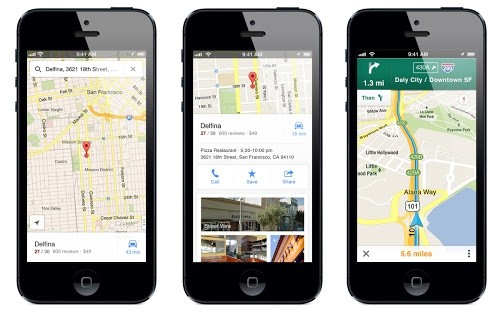Google Maps made its much anticipated return to the iPhone last night, almost three months after Apple replaced it as the default mapping system in iOS 6 with its own in-house maps app. The new app has been built from the ground up and includes features that have been long available for Android, such as voice-guided turn-by-turn navigation, transit directions, and live traffic information.
The new Google Maps uses vector imaging similar to Apple's Maps, rather than bit mapped tiles on iOS 5 and earlier, resulting in faster load times with information scaling that incrementally displays new data as you zoom in. Tilting is also smoother as a result and rotating is now supported for both 2D and 3D images.

It's not integrated with Siri and since you can't change the default map client on iOS, asking Apple's robotic assistant for directions will just take you to Apple Maps. You can use Siri to launch Google Maps, however, and then conduct your search from there. Another feature making a comeback is Street View, complete with 360-degree panoramas, and the ability to see inside participating buildings and businesses.
The new app is available in roughly 40 countries and 29 languages. Google also launched an SDK that gives developers a chance to integrate it into their apps and bypass Apple's own mapping hooks.
All in all Google Maps for iOS is much better than it ever was on Apple's platform – The New York Times' David Pogue says Google even believes in some ways it's better than the Android version, noting that "The brand-new, completely rethought design is slick, simple and coherent" whereas Google Maps for Android "accommodated its evolving feature set mainly by piling on menus."
Whether Google was purposely dragging its feet on improving its iOS apps to keep up with Android, or Apple wasn't allowing it to do what it wanted, Apple kicking out Google's apps from iOS eventually resulted in a better experience for iPhones users with the revamped YouTube app and now Google Maps.
Apple's own Maps app was met with intense criticism back in September. Users complained the app offered poor directions, missing or outright wrong data, and lousy 3D imagery. This led to an apology letter from CEO Tim Cook and promises to make the app "even better", followed by the surprising departure of Scott Forstall, who refused to sign the apology letter, and product manager for Apple's Maps Richard Williamson.